Numerical Studies on Failure Mechanisms of All-Composite Sandwich Structure with Honeycomb Core under Compression and Impact Loading Conditions
Abstract
:1. Introduction
2. Analysis Strategy
2.1. MMF Theory
2.2. Mixed-Mode ECZM
2.3. Cohesive Contact Approach
3. Finite Element Model
3.1. Compression Model
3.2. Impact Model
4. Results and Discussion
4.1. Compression Failure Mechanism
4.2. Impact Response and Failure Mechanism
5. Conclusions
Author Contributions
Funding
Data Availability Statement
Acknowledgments
Conflicts of Interest
References
- Sun, Z.; Li, D.; Zhang, W.S.; Shi, S.S.; Guo, X. Topological optimization of biomimetic sandwich structures with hybrid core and CFRP face sheets. Compos. Sci. Technol. 2017, 142, 79–90. [Google Scholar] [CrossRef]
- Nath, S.D.; Nilufar, S. Performance Evaluation of Sandwich Structures Printed by Vat Photopolymerization. Polymers 2022, 14, 1513. [Google Scholar] [CrossRef] [PubMed]
- Al-Fatlawi, A.; Jarmai, K.; Kovacs, G. Optimization of a Totally Fiber-Reinforced Plastic Composite Sandwich Construction of Helicopter Floor for Weight Saving, Fuel Saving and Higher Safety. Polymers 2021, 13, 2735. [Google Scholar] [CrossRef] [PubMed]
- Elangovan, H.; Rajamohan, V. Dynamic characterization of tapered composite sandwich plate with honeycomb core: Numerical and experimental investigations. Thin Wall. Struct. 2022, 178, 109515. [Google Scholar] [CrossRef]
- Patel, S.; Patel, M. The efficient design of hybrid and metallic sandwich structures under air blast loading. J. Sandw. Struct. Mater. 2022, 24, 1706–1725. [Google Scholar] [CrossRef]
- Xue, D.B.; He, L.; Tan, S.; Li, Y.S.; Xue, P.; Yang, X.H. Study on compression characteristics of honeycomb sandwich structure with multistage carbon fiber reinforced composites. Polym. Compos. 2022, 43, 6252–6264. [Google Scholar] [CrossRef]
- Patekar, V.; Kale, K. State of the art review on mechanical properties of sandwich composite structures. Polym. Compos. 2022, 43, 5820–5830. [Google Scholar] [CrossRef]
- Sun, G.Y.; Chen, D.D.; Huo, X.T.; Zheng, G.; Li, Q. Experimental and numerical studies on indentation and perforation characteristics of honeycomb sandwich panels. Compos. Struct. 2018, 184, 110–124. [Google Scholar] [CrossRef]
- Gunes, R.; Arslan, K. Development of numerical realistic model for predicting low-velocity impact response of aluminium honeycomb sandwich structures. J. Sandw. Struct. Mater. 2016, 18, 95–112. [Google Scholar] [CrossRef]
- He, W.T.; Yao, L.; Meng, X.J.; Sun, G.Y.; Xie, D.; Liu, J.X. Effect of structural parameters on low-velocity impact behavior of aluminum honeycomb sandwich structures with CFRP face sheets. Thin Wall. Struct. 2019, 137, 411–432. [Google Scholar] [CrossRef]
- Wu, Y.H.; Qiang, L.; Fu, J.; Li, Q.; Hui, D. Dynamic crash responses of bio-inspired aluminum honeycomb sandwich structures with CFRP panels. Compos. Part B-Eng. 2017, 121, 122–133. [Google Scholar] [CrossRef]
- Gao, G.W.; Tang, E.L.; Yang, G.L.; Han, Y.F.; Chen, C.; Chang, M.Z.; Guo, K.; He, L.P. Energy absorption performance and optimization of combination modes for carbon fiber reinforced plastics/aluminum honeycomb sandwich panels. Polym. Compos. 2022, 43, 52–67. [Google Scholar] [CrossRef]
- Wang, J.F.; Shi, C.Y.; Yang, N.; Sun, H.N.; Liu, Y.Q.; Song, B.Y. Strength, stiffness, and panel peeling strength of carbon fiber-reinforced composite sandwich structures with aluminum honeycomb cores for vehicle body. Compos. Struct. 2018, 184, 1189–1196. [Google Scholar] [CrossRef]
- Cai, Z.B.; Li, Z.Y.; Ding, Y.; Zheng, J.; Liu, J.H.; Zhou, Z.R. Preparation and impact resistance performance of bionic sandwich structure inspired from beetle forewing. Compos. Part B-Eng. 2019, 161, 490–501. [Google Scholar] [CrossRef]
- Liu, L.Q.; Wang, H.; Guan, Z.W. Experimental and numerical study on the mechanical response of Nomex honeycomb core under transverse loading. Compos. Struct. 2015, 121, 304–314. [Google Scholar] [CrossRef]
- Kim, G.; Sterkenburg, R.; Tsutsui, W. Investigating the effects of fluid intrusion on Nomex (R) honeycomb sandwich structures with carbon fiber facesheets. Compos. Struct. 2018, 206, 535–549. [Google Scholar] [CrossRef]
- Chen, Y.; Hou, S.J.; Fu, K.K.; Han, X.; Ye, L. Low-velocity impact response of composite sandwich structures: Modelling and experiment. Compos. Struct. 2017, 168, 322–334. [Google Scholar] [CrossRef]
- Stocchi, A.; Colabella, L.; Cisilino, A.; Alvarez, V. Manufacturing and testing of a sandwich panel honeycomb core reinforced with natural-fiber fabrics. Mater. Design 2014, 55, 394–403. [Google Scholar] [CrossRef]
- Sugiyama, K.; Matsuzaki, R.; Ueda, M.; Todoroki, A.; Hirano, Y. 3D printing of composite sandwich structures using continuous carbon fiber and fiber tension. Compos. Part A-Appl. Sci. Manuf. 2018, 113, 114–121. [Google Scholar] [CrossRef]
- Wei, X.Y.; Li, D.F.; Xiong, J. Fabrication and mechanical behaviors of an all-composite sandwich structure with a hexagon honeycomb core based on the tailor-folding approach. Compos. Sci. Technol. 2019, 184, 107878. [Google Scholar] [CrossRef]
- Zhu, K.Y.; Zheng, X.T.; Zhang, C.; Chen, N.; Han, Y.G.; Yan, L.L.; Quaresimin, M. Compressive response and energy absorption of all-composite sandwich panels with channel cores. Compos. Struct. 2022, 289, 115461. [Google Scholar] [CrossRef]
- Zaharia, S.M.; Enescu, L.A.; Pop, M.A. Mechanical Performances of Lightweight Sandwich Structures Produced by Material Extrusion-Based Additive Manufacturing. Polymers 2020, 12, 1740. [Google Scholar] [CrossRef] [PubMed]
- Aktay, L.; Johnson, A.F.; Kroplin, B.H. Numerical modelling of honeycomb core crush behaviour. Eng. Fract. Mech. 2008, 75, 2616–2630. [Google Scholar] [CrossRef]
- Sun, S.Y.M.; Liu, D.; Sheng, Y.L.; Feng, S.S.; Zhu, H.B.; Lu, T.J. Out-of-plane compression of a novel hybrid corrugated core sandwich panel. Compos. Struct. 2021, 272, 114222. [Google Scholar] [CrossRef]
- Demirci, M.T. Investigation of low-velocity impact behavior of aluminum honeycomb composite sandwiches with GNPs doped BFR laminated face-sheets and interfacial adhesive for aircraft structures. Polym. Compos. 2022, 43, 5675–5689. [Google Scholar] [CrossRef]
- Yang, C.H.; Ma, W.N.; Zhang, Z.D.; Zhong, J.L. Low-Velocity Impact Behavior of Sandwich Plates with FG-CNTRC Face Sheets and Negative Poisson’s Ratio Auxetic Honeycombs Core. Polymers 2022, 14, 2938. [Google Scholar] [CrossRef]
- Xie, H.L.; Fang, H.; Li, X.L.; Li, W.; Wu, P.; Yu, Y. Low-velocity impact damage detection and characterization in composite sandwich panels using infrared thermography. Compos. Struct. 2021, 269, 114008. [Google Scholar] [CrossRef]
- Hayta, N.; Kaya, G. Experimental investigation on impact response of sandwich composites integrated with a novel 3D multi-layer stitched core. Compos. Struct. 2022, 296, 115888. [Google Scholar] [CrossRef]
- Riccio, A.; Raimondo, A.; Saputo, S.; Sellitto, A.; Battaglia, M.; Petrone, G. A numerical study on the impact behaviour of natural fibres made honeycomb cores. Compos. Struct. 2018, 202, 909–916. [Google Scholar] [CrossRef]
- Zhang, X.Y.; Xu, F.; Zang, Y.Y.; Feng, W. Experimental and numerical investigation on damage behavior of honeycomb sandwich panel subjected to low-velocity impact. Compos. Struct. 2020, 236, 111882. [Google Scholar] [CrossRef]
- Palomba, G.; Epasto, G.; Crupi, V.; Guglielmino, E. Single and double-layer honeycomb sandwich panels under impact loading. Int. J. Impact Eng. 2018, 121, 77–90. [Google Scholar] [CrossRef]
- Komorek, A.; Przybylek, P.; Szczepaniak, R.; Godzimirski, J.; Roskowicz, M.; Imilowski, S. The Influence of Low-Energy Impact Loads on the Properties of the Sandwich Composite with a Foam Core. Polymers 2022, 14, 1566. [Google Scholar] [CrossRef] [PubMed]
- Lou, X.F.; Cai, H.N.; Yu, P.F.; Jiao, F.; Han, X.C. Failure analysis of composite laminate under low-velocity impact based on micromechanics of failure. Compos. Struct. 2017, 163, 238–247. [Google Scholar] [CrossRef]
- Han, X.C.; Cai, H.N.; Sun, J.; Wei, Z.Y.; Huang, Y.P.; Meng, L.Q. Behaviors of Composite Laminates Under Low-Energy Impact Using a Novel Analytical Framework. Int. J. Appl. Mech. 2022, 14, 2250004. [Google Scholar] [CrossRef]
- Lou, X.F.; Han, X.C.; Cai, H.N. Impact behavior analysis of carbon fiber reinforced aluminum laminates based on a micro-mechanical damage model. Mater. Res. Express 2019, 6, 065614. [Google Scholar] [CrossRef]
- Benzeggagh, M.L.; Kenane, M. Measurement of mixed-mode delamination fracture toughness of unidirectional glass/epoxy composites with mixed-mode bending apparatus. Compos. Sci. Technol. 1996, 56, 439–449. [Google Scholar] [CrossRef]
- Russell, B.P.; Deshpande, V.S.; Wadley, H.N.G. Quasistatic Deformation and Failure Modes of Composite Square Honeycombs. J. Mech. Mater. Struct. 2008, 3, 1315–1340. [Google Scholar] [CrossRef]
- Pehlivan, L.; Baykasoglu, C. An experimental study on the compressive response of CFRP honeycombs with various cell configurations. Compos. Part B-Eng. 2019, 162, 653–661. [Google Scholar] [CrossRef]
- Zhang, Y.W.; Liu, T.; Tizani, W. Experimental and numerical analysis of dynamic compressive response of Nomex honeycombs. Compos. Part B-Eng. 2018, 148, 27–39. [Google Scholar] [CrossRef]

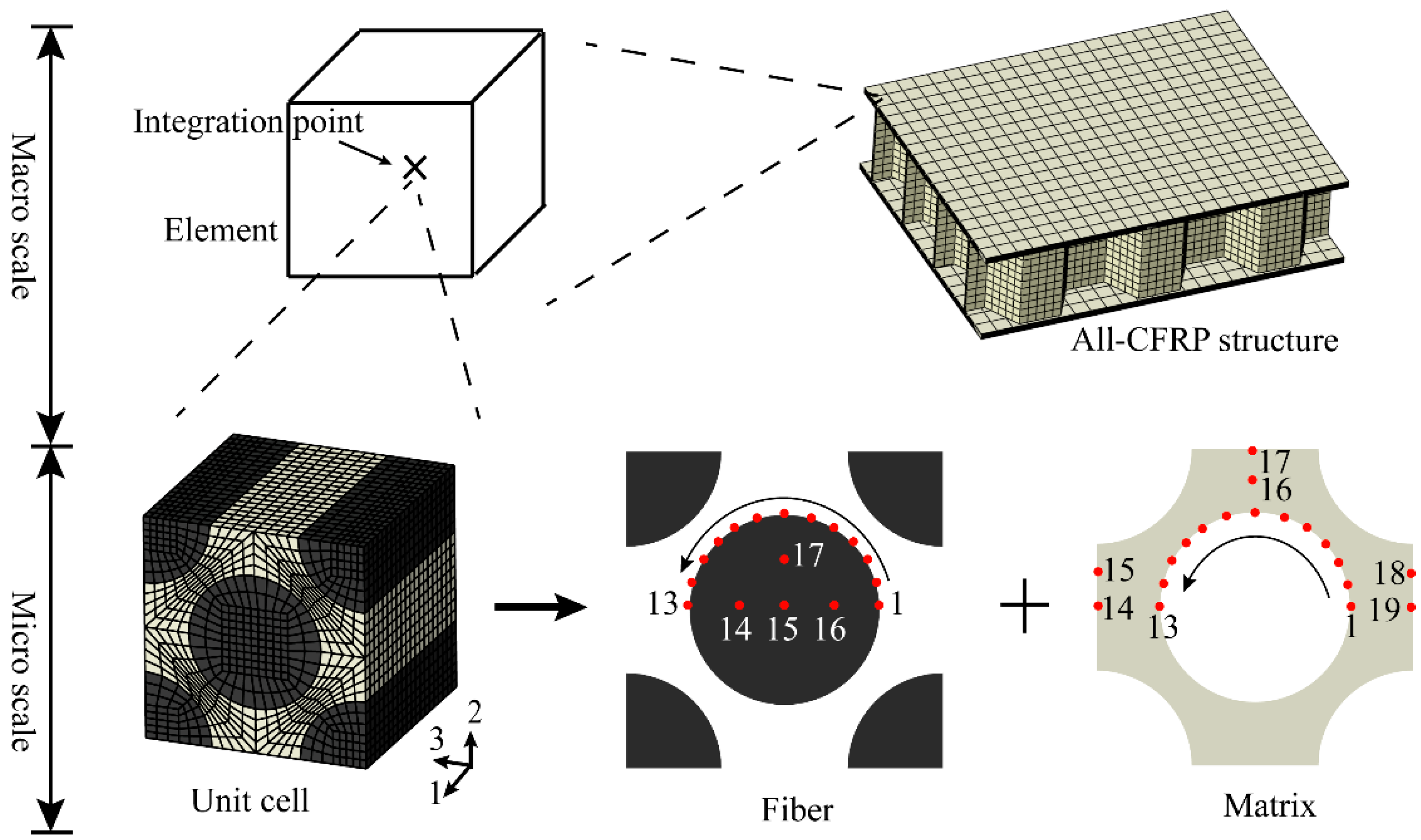
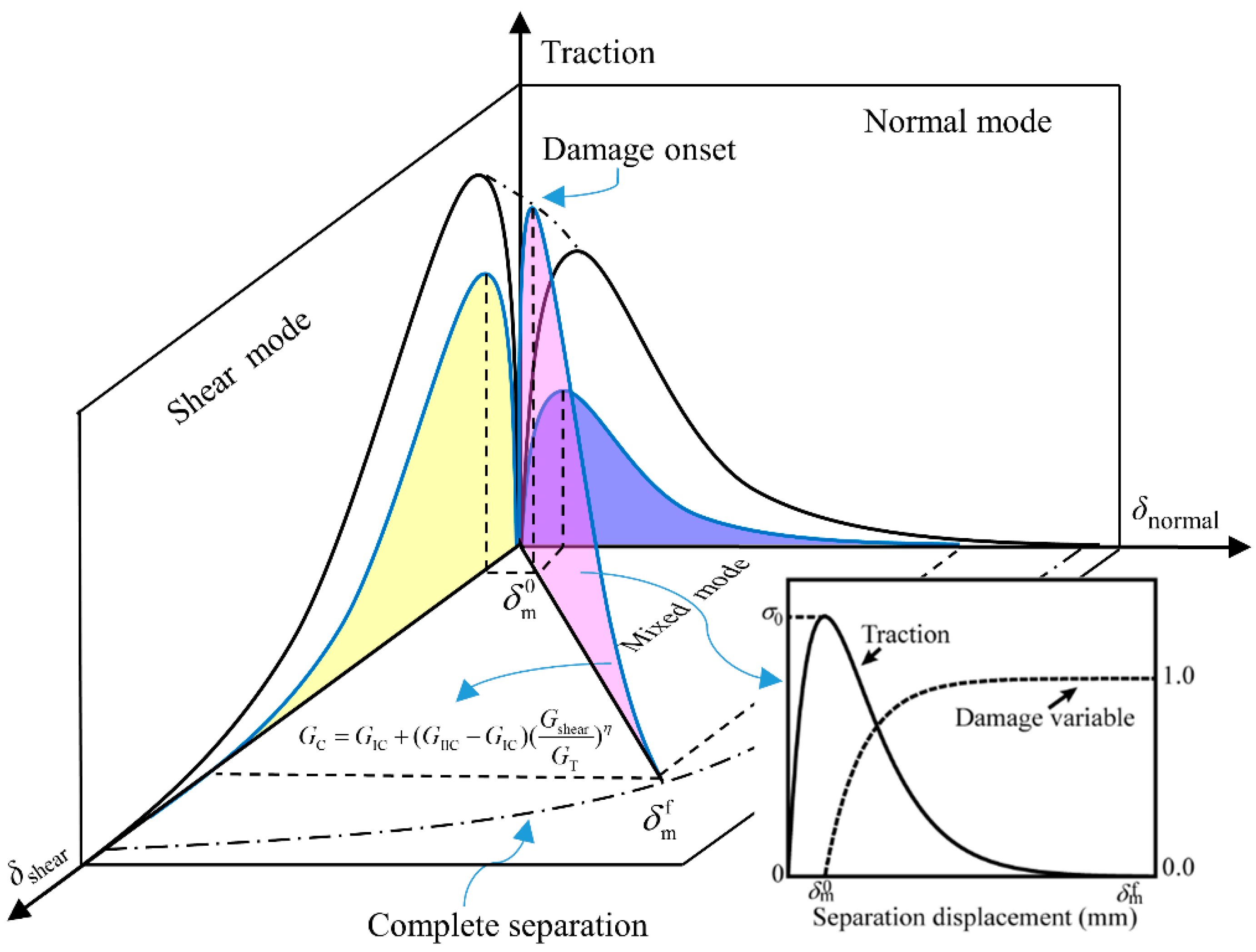
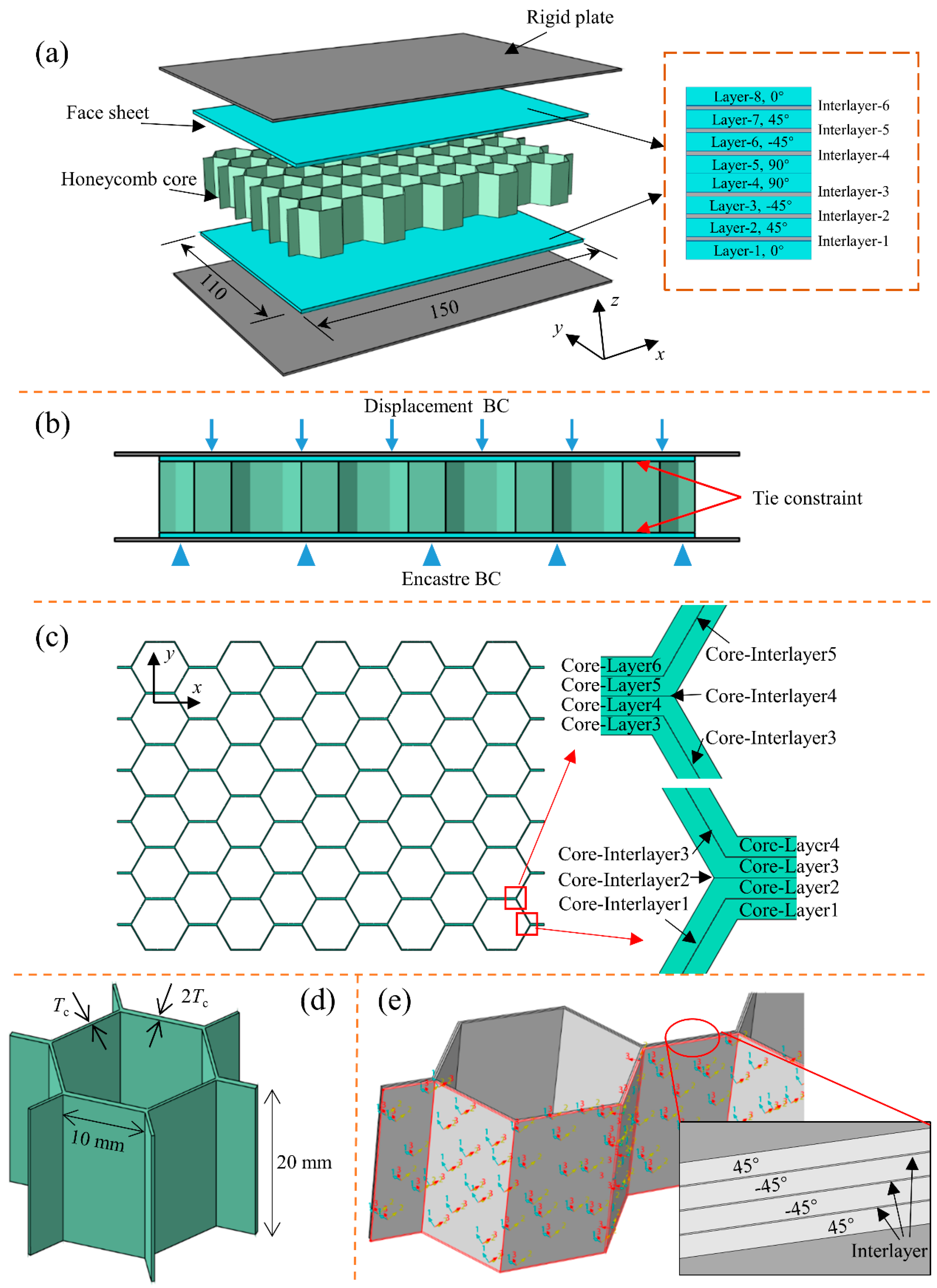
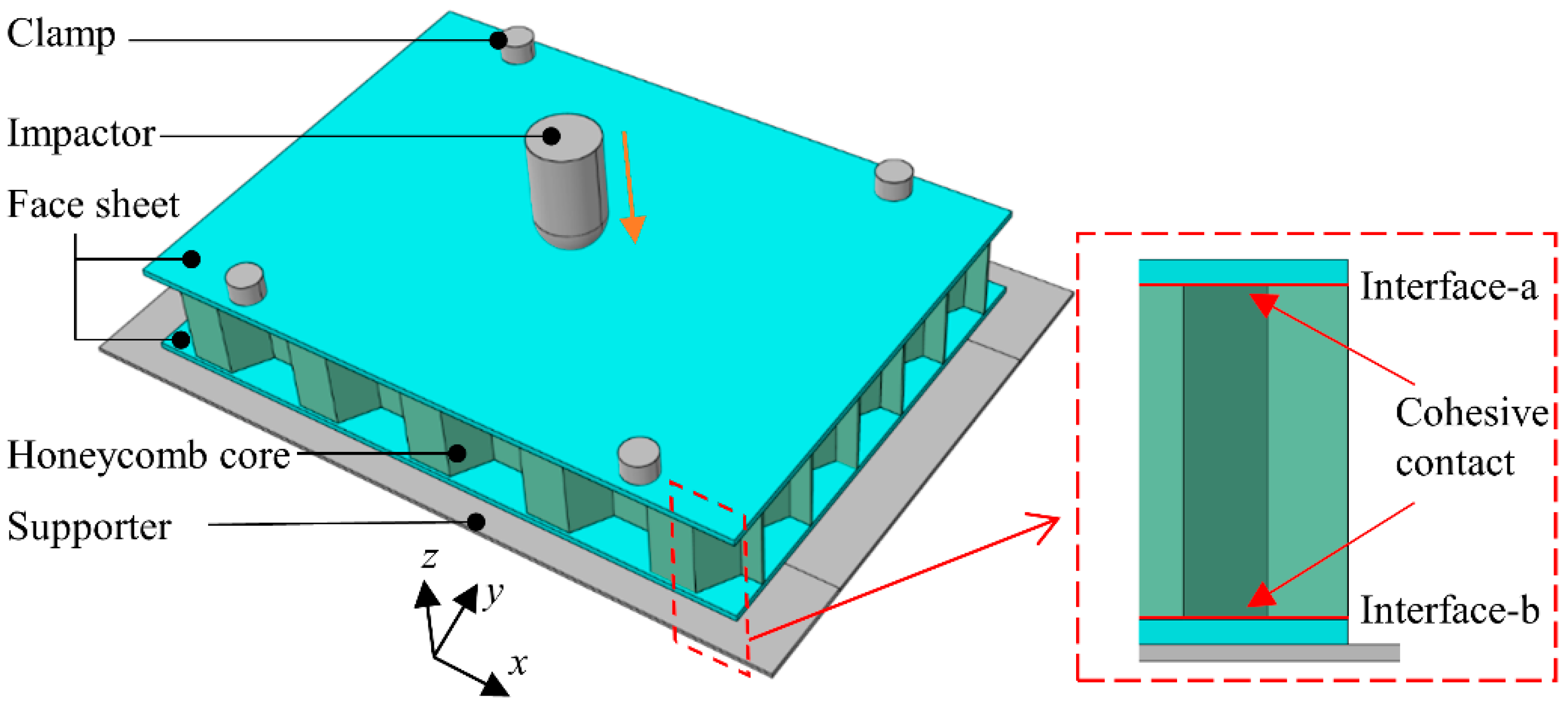
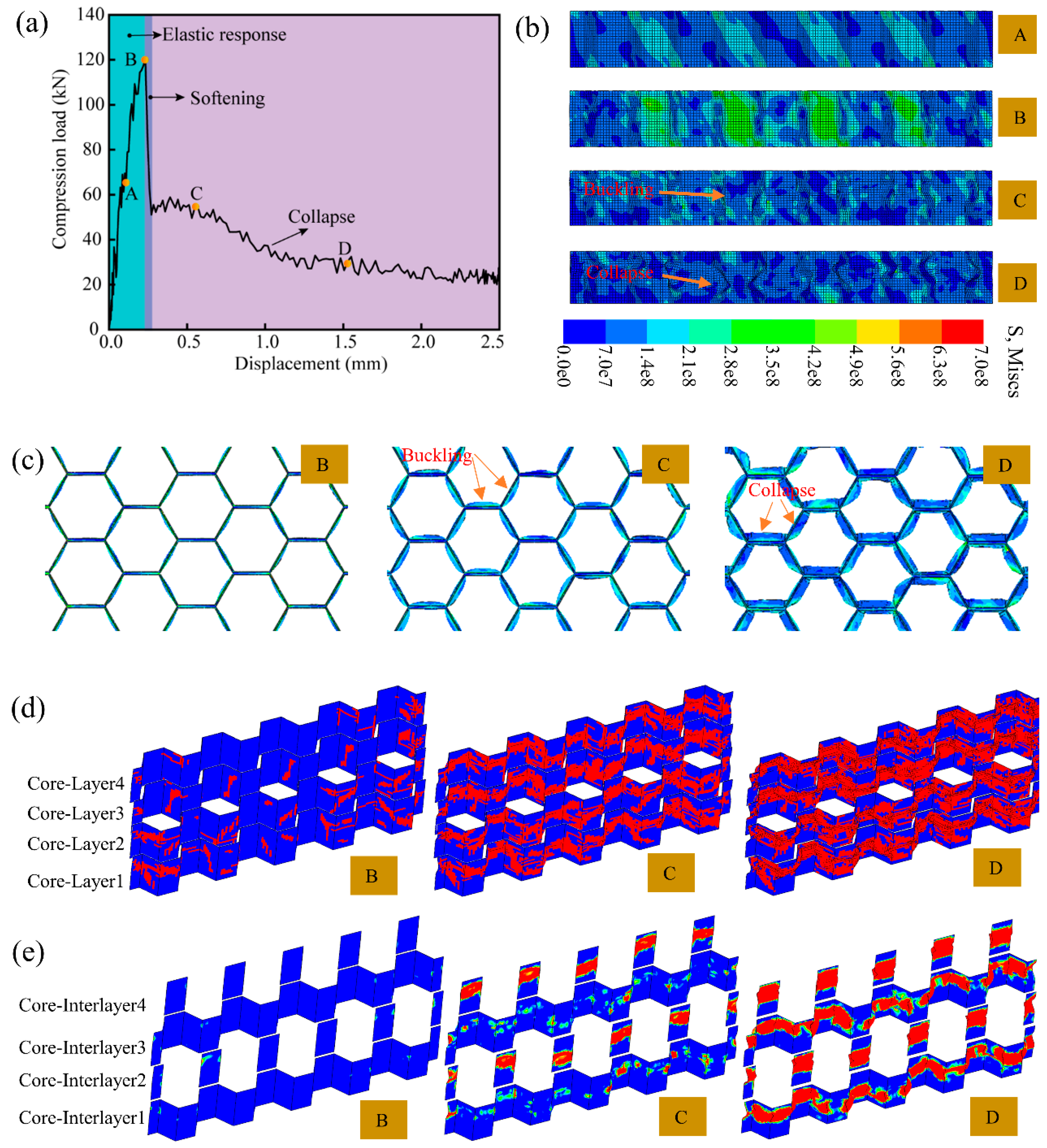


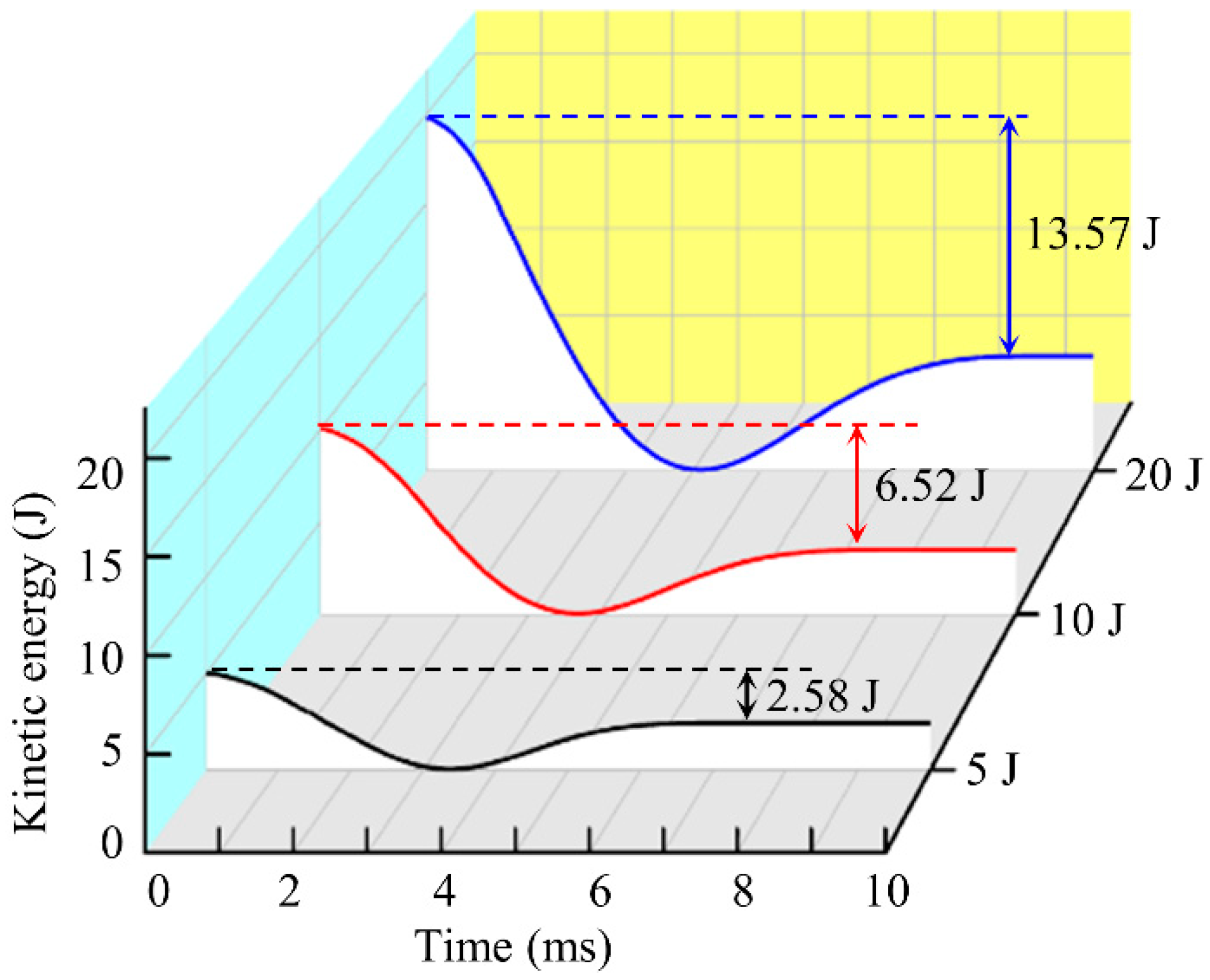


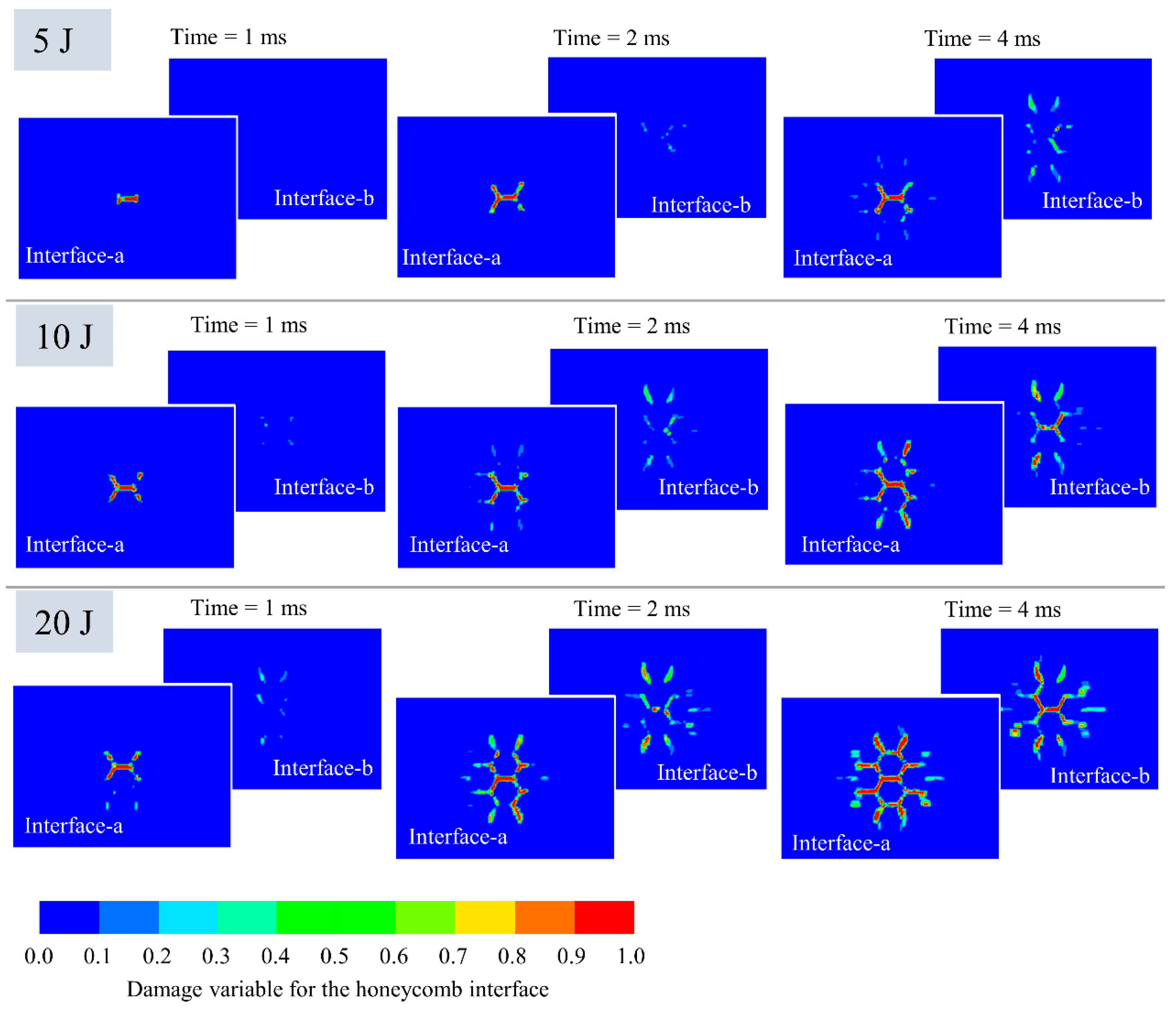
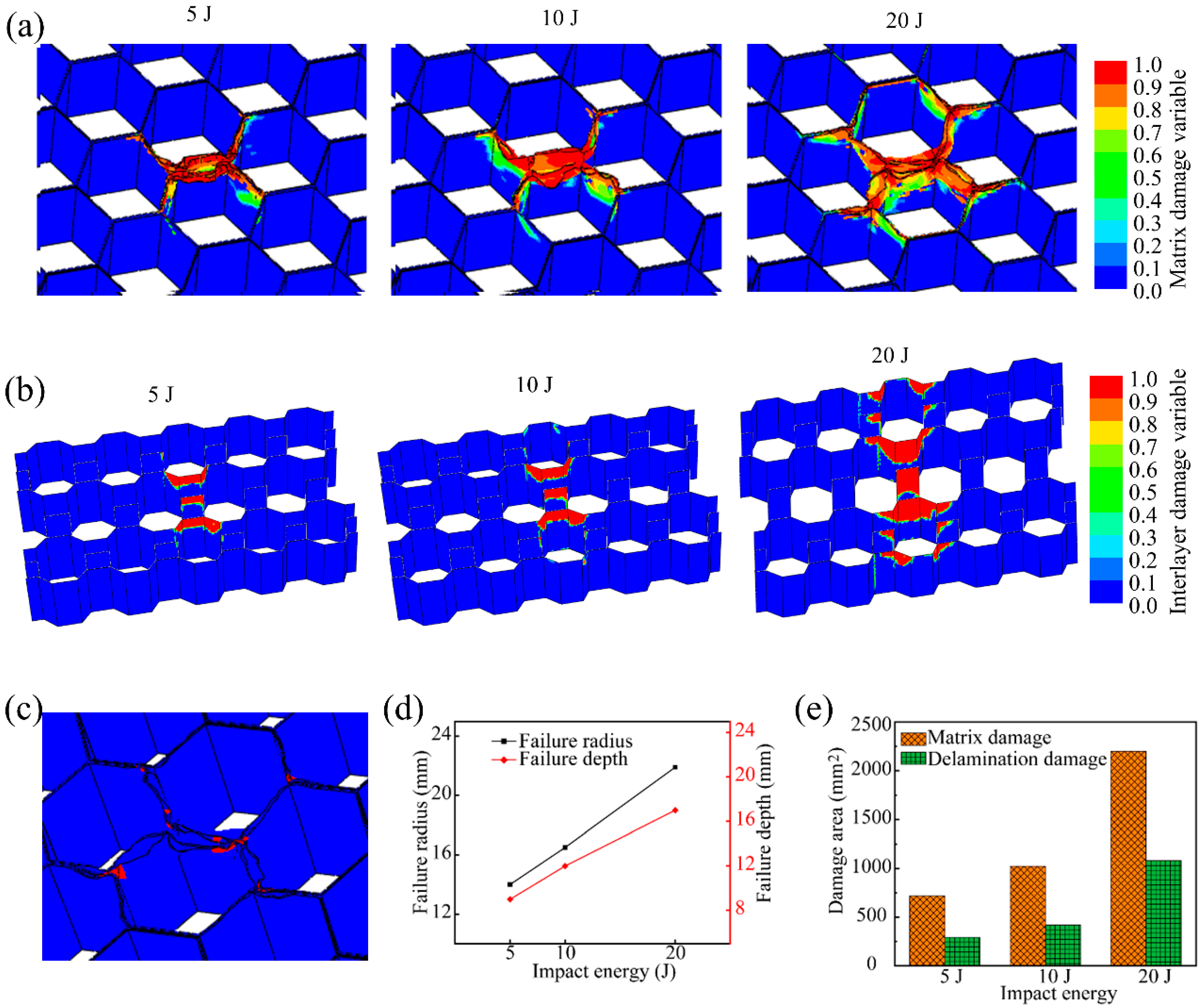
Publisher’s Note: MDPI stays neutral with regard to jurisdictional claims in published maps and institutional affiliations. |
© 2022 by the authors. Licensee MDPI, Basel, Switzerland. This article is an open access article distributed under the terms and conditions of the Creative Commons Attribution (CC BY) license (https://creativecommons.org/licenses/by/4.0/).
Share and Cite
Han, X.; Cai, H.; Sun, J.; Wei, Z.; Huang, Y.; Wang, A. Numerical Studies on Failure Mechanisms of All-Composite Sandwich Structure with Honeycomb Core under Compression and Impact Loading Conditions. Polymers 2022, 14, 4047. https://doi.org/10.3390/polym14194047
Han X, Cai H, Sun J, Wei Z, Huang Y, Wang A. Numerical Studies on Failure Mechanisms of All-Composite Sandwich Structure with Honeycomb Core under Compression and Impact Loading Conditions. Polymers. 2022; 14(19):4047. https://doi.org/10.3390/polym14194047
Chicago/Turabian StyleHan, Xuecheng, Hongneng Cai, Jie Sun, Zhiyuan Wei, Yaping Huang, and Ang Wang. 2022. "Numerical Studies on Failure Mechanisms of All-Composite Sandwich Structure with Honeycomb Core under Compression and Impact Loading Conditions" Polymers 14, no. 19: 4047. https://doi.org/10.3390/polym14194047






